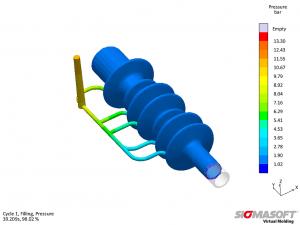Technical Report 2018-07-13
Content shown in the technical articles are the sole opinion and views of the authors or companies, which are not necessarily congruent to opinion and views of the editors.
|
SIGMA Engineering: Finding the Optimal Runner System via Virtual DoE Assuring quality of elastomer components and minimizing wasteVanessa Frekers, SIGMA Engineering GmbH Increasingly complex plastic parts, which need to meet economical as well as ecological standards, pose an enormous challenge for injection molders. Tools like the virtual DoE, featured by the SIGMASOFT® Virtual Molding Technology, help rising to these challenges, e.g. by finding the optimal mold design for runner systems. This can help to increase the part quality by a substantial amount while reducing scrap in early stages of the development phase.  Bild 1: Druckverteilung während der Füllung im ursprünglichen Design, das Angusssystem verursacht eine deutliche Unbalanciertheit bei der Füllung - (Bild: Sigma Engineering) The example at hand illustrates one of these newly arousing problems. At the beginning of the development phase the questions for the ideal part filling and a suitable concept for connection and sprue came up. At the same time the part should be filled with as little pressure as possible. A first part and sprue design allowed the low pressure demand (Figure 1, left), however, the filling behavior showed significant imbalance. The first measures taken into consideration were a changed number of gates, altered gate thicknesses and different hot runner positions in relation to the gates. Instead of testing the numerous possible combinations of these measures using trial-and-error on the computer manually, a virtual DoE (Design of Experiments) was conducted. Based on filling time difference and pressure demand of the part’s ends, every possible combination was evaluated simultaneously.  Bild 2: Druckverteilung in der mittels virtueller DoE optimierten Version; bei leicht erhöhtem Druckbedarf zeigt die optimierte Version ein gleichmäßigeres Füllverhalten - (Bild: Sigma Engineering) In the example at hand, the balanced filling of the part was rated higher, leading to a final design which focuses on this aspect despite having a slightly higher pressure demand (Figure 2). Therefore, SIGMASOFT® Virtual Molding was able to find the best compromise between different criteria, leading to the optimal design possible under the given circumstances. The virtual mold design in an early development stage eliminated the need for mold changes, thus increasing the part quality substantially. SIGMA Engineering GmbH Kackertstr. 16-18 Phone: +49 (0) 241 89 495-0 Internet: www.sigmasoft.de |
 back to the list back to the list |  back to top back to top |



